

Packaging. Printing. Printing. How it's made - Package printing. Video. White Board. Metal Products. Cymbals. Cymbal. Characteristic rock hi-hat pattern. play Cymbals are a common percussion instrument.
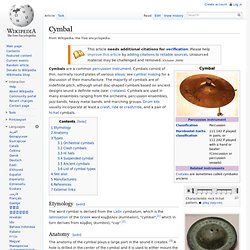
Cymbals consist of thin, normally round plates of various alloys; see cymbal making for a discussion of their manufacture. The majority of cymbals are of indefinite pitch, although small disc-shaped cymbals based on ancient designs sound a definite note (see: crotales). Cymbals are used in many ensembles ranging from the orchestra, percussion ensembles, jazz bands, heavy metal bands, and marching groups. Etymology[edit] Anatomy[edit] Cymbals are measured by their diameter often in inches or centimeters. The profile of the cymbal is the vertical distance of the bow from the bottom of the bell to the cymbal edge (higher profile cymbals are more bowl shaped). How It's Made Cymbals. Pouring Cast Into Cymbal Mould. HAmmering of cast. Radiator. Alluminium Can. How It's Made Aluminum Cans (Sam's Club Choice)
Aluminium-Extrusion-Press. Aluminium Coil Sheet. Hammer. How It's Made - Train Wheels. Mild Steel V High Carbon Steel. A Bit About Hammers. Cold, Warm, and Hot forging. Cold, Warm, and Hot Forging -- What's the Difference?
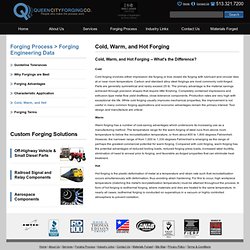
Cold Cold forging involves either impression die forging or true closed die forging with lubricant and circular dies at or near room temperature. Carbon and standard alloy steel forgings are most commonly cold-forged. Parts are generally symmetrical and rarely exceed 25 lb. The primary advantage is the material savings achieved through precision shapes that require little finishing. Warm. How hammer is made - material, making, history, used, components, structure, steps, Types of Hammers, Design, Raw Materials, The Manufacturing Process of hammer. Background A hammer is a handheld tool used to strike another object.
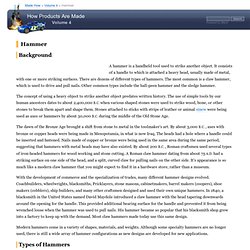
It consists of a handle to which is attached a heavy head, usually made of metal, with one or more striking surfaces. There are dozens of different types of hammers. The most common is a claw hammer, which is used to drive and pull nails. Other common types include the ball-peen hammer and the sledge hammer. The concept of using a heavy object to strike another object predates written history. The dawn of the Bronze Age brought a shift from stone to metal in the toolmaker's art. With the development of commerce and the specialization of trades, many different hammer designs evolved.
Hammer - Wikipedia. The hammer is a basic tool of many professions.

The usual features are a handle and a head, with most of the weight in the head. How its made hammer. Bike Frame. How It's Made Bicycle. Steel. Manufacturing. Composite Products. Carbon Mast. Carbon fibre - The Sheets. Some boat hulls can be made from Carbon. Why on a hull? Hydrofoiling Moth. Layered one sheet at a time in a mould. Why do you need Resin? Resins. Boat hulls. How It's Made: Fiberglass Boats. Ceramic Products. Ceramic Brakes. Brake Tech - Why Ceramic Brake Pads? Lea esta página en español We want our vehicle's brake system to offer smooth, quiet braking capabilities under a wide range of temperature and road conditions.
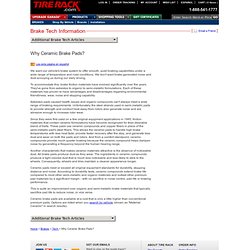
We don't want brake-generated noise and dust annoying us during our daily driving. To accommodate this, brake friction materials have evolved significantly over the years. They've gone from asbestos to organic to semi-metallic formulations. Each of these materials has proven to have advantages and disadvantages regarding environmental friendliness, wear, noise and stopping capability. Asbestos pads caused health issues and organic compounds can't always meet a wide range of braking requirements.
Since they were first used on a few original equipment applications in 1985, friction materials that contain ceramic formulations have become recognized for their desirable blend of traits. Another characteristic that makes ceramic materials attractive is the absence of noticeable dust. How it works. How it works. How Its Made - Ceramic Composite Brake Discs. Hydrothermal synthesis. A synthetic quartz crystal grown by the hydrothermal method Hydrothermal synthesis includes the various techniques of crystallizing substances from high-temperature aqueous solutions at high vapor pressures; also termed "hydrothermal method".
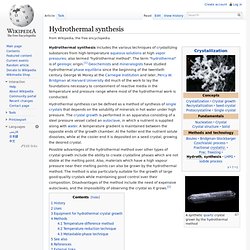
The term "hydrothermal" is of geologic origin.[1] Geochemists and mineralogists have studied hydrothermal phase equilibria since the beginning of the twentieth century. George W. Morey at the Carnegie Institution and later, Percy W. Bridgman at Harvard University did much of the work to lay the foundations necessary to containment of reactive media in the temperature and pressure range where most of the hydrothermal work is conducted.
Terracotta Plant Pot. Terracotta. Terracotta, Terra cotta or Terra-cotta (Italian: "baked earth",[1] from the Latin terra cotta), a type of earthenware, is a clay-based unglazed or glazed ceramic,[2] where the fired body is porous.[3][4][5][6] Its uses include vessels (notably flower pots), water and waste water pipes, bricks, and surface embellishment in building construction, along with sculpture such as the Terracotta Army and Greek terracotta figurines.
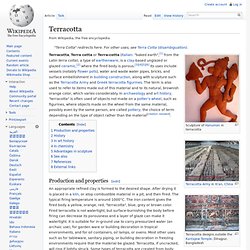
The term is also used to refer to items made out of this material and to its natural, brownish orange color, which varies considerably. In archaeology and art history, "terracotta" is often used of objects not made on a potter's wheel, such as figurines, where objects made on the wheel from the same material, possibly even by the same person, are called pottery; the choice of term depending on the type of object rather than the material[citation needed]. Production and properties[edit] How It's Made Toilet. Terracotta manufacture.
Wooden products. Wooden Bench (outdoor) Wood varnish. Protecting the product. Wood finishing. A worker sprays a urethane finish onto a timber Wood finishing refers to the process of refining or protecting a wooden surface, especially in the production of furniture.

Basic wood finishing procedure[edit] Once the wood surface is prepared and stained, the finish is applied. It usually consists of several coats of wax, shellac, drying oil, lacquer, varnish, or paint, and each coat is typically followed by sanding. Finally, the surface may be polished or buffed using steel wool, pumice, rotten stone or other materials, depending on the shine desired. How to Use a Block Plane. How it works (basic) How It's Made Drumsticks. Guitar Body. Possible guitar body materials - Mahogany. Basswood. 120-150 Glass Paper. Planing the body to make it flat. Cut out the body with a Jig Saw. How It's Made: Electric Guitar (Part 1) Polymer Products. Plastic Bottle. Material. Injection/ Blow moulding. How Plastic Bottles are Made. Yellow hot wheels toy car. HIPs. Injection Moulding.
Vinyl Stickers. Aluminium parts. How It's Made - Model Racing Cars (Scalextric) Rubik’s Official Website. Polymer unknown but... Injection Moulding of Plastics. Vinyl stickers rather than paint. Vinyl Cutters. Automated Labelling / Sticker Application. Die cutting sheet stickers.